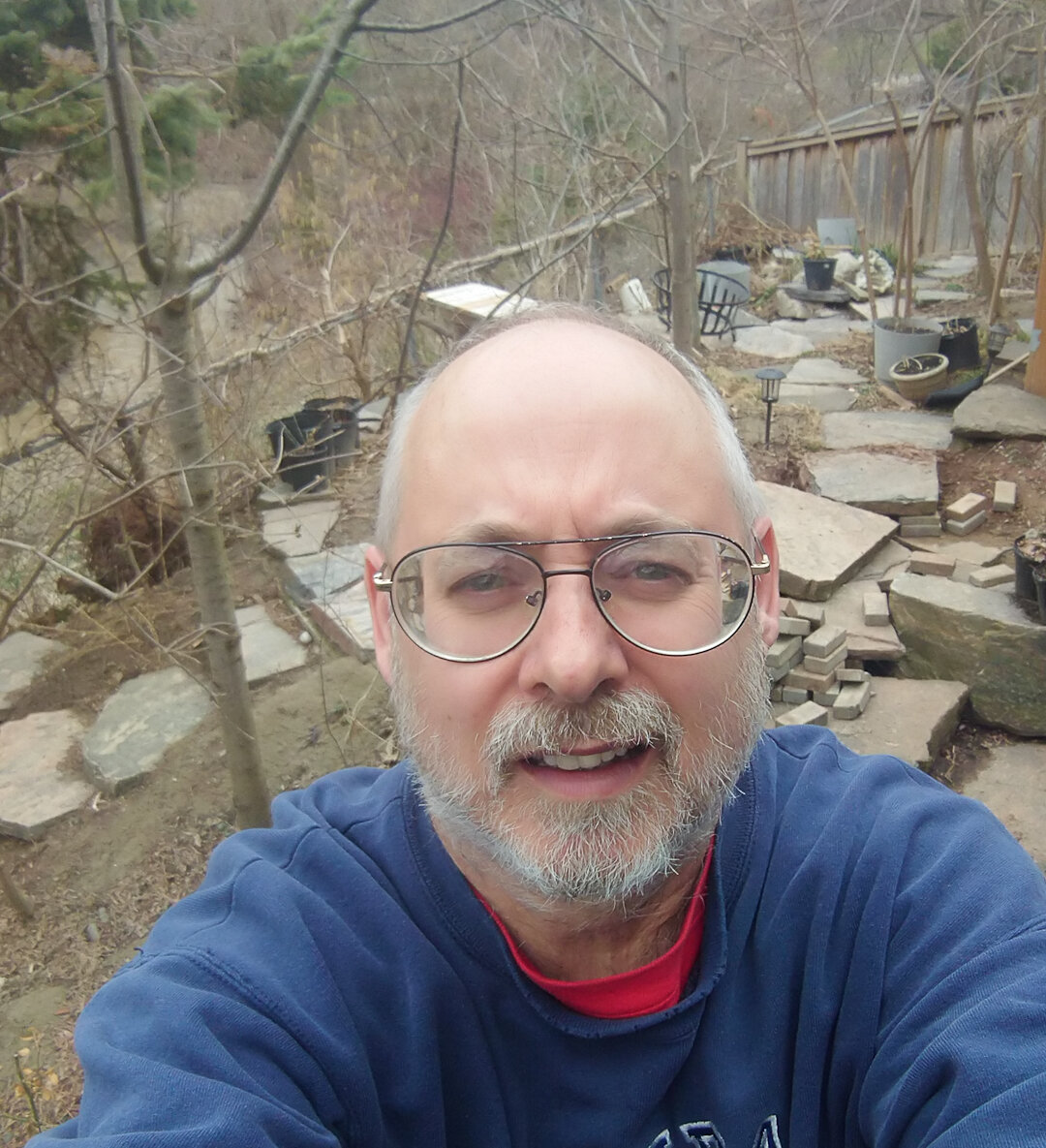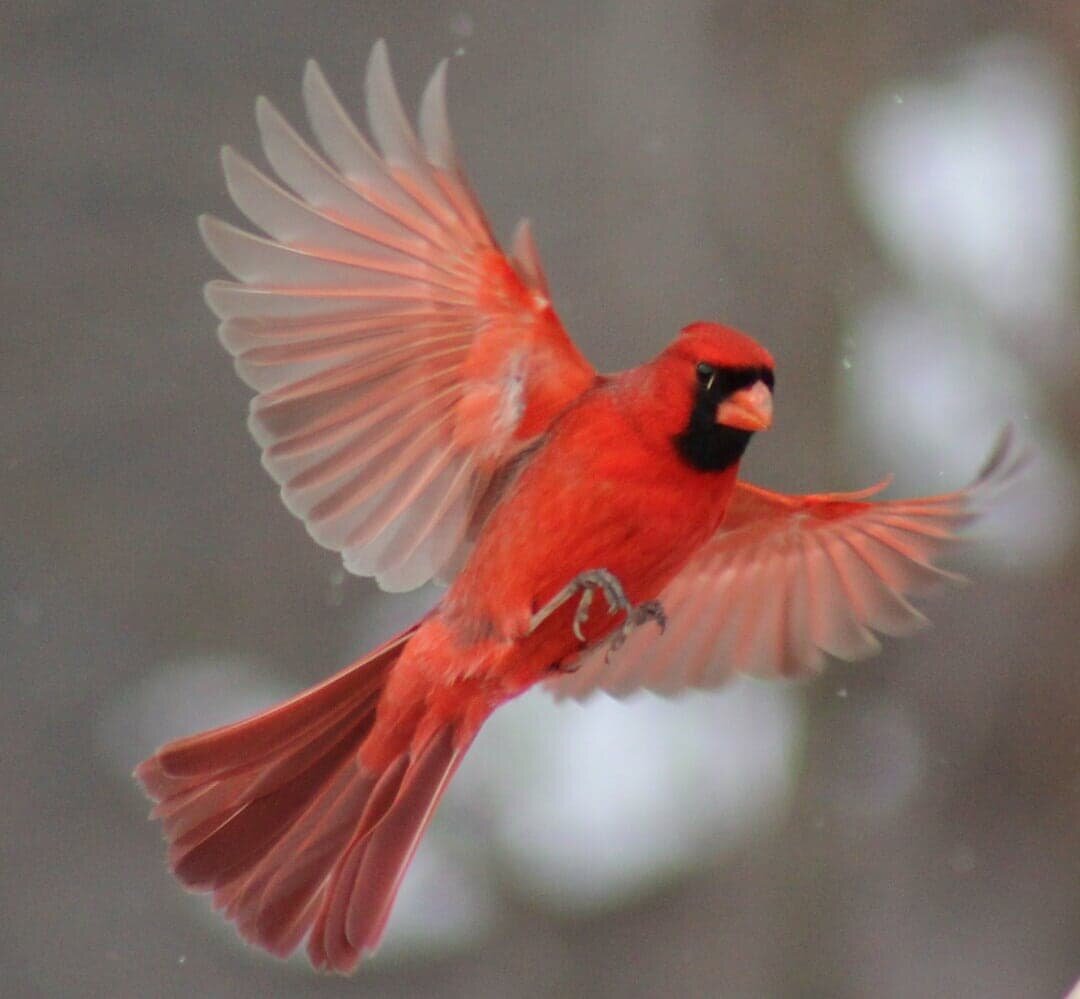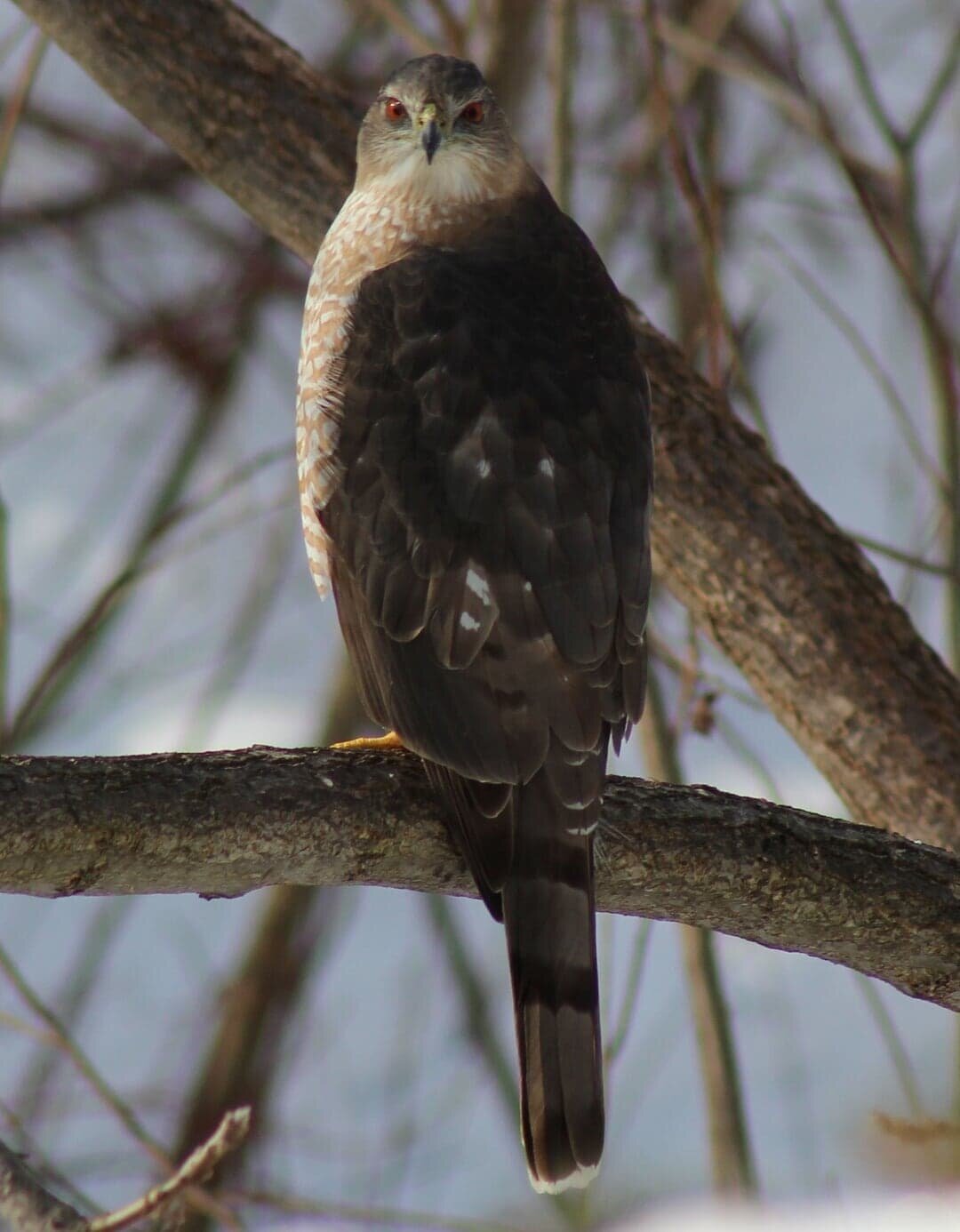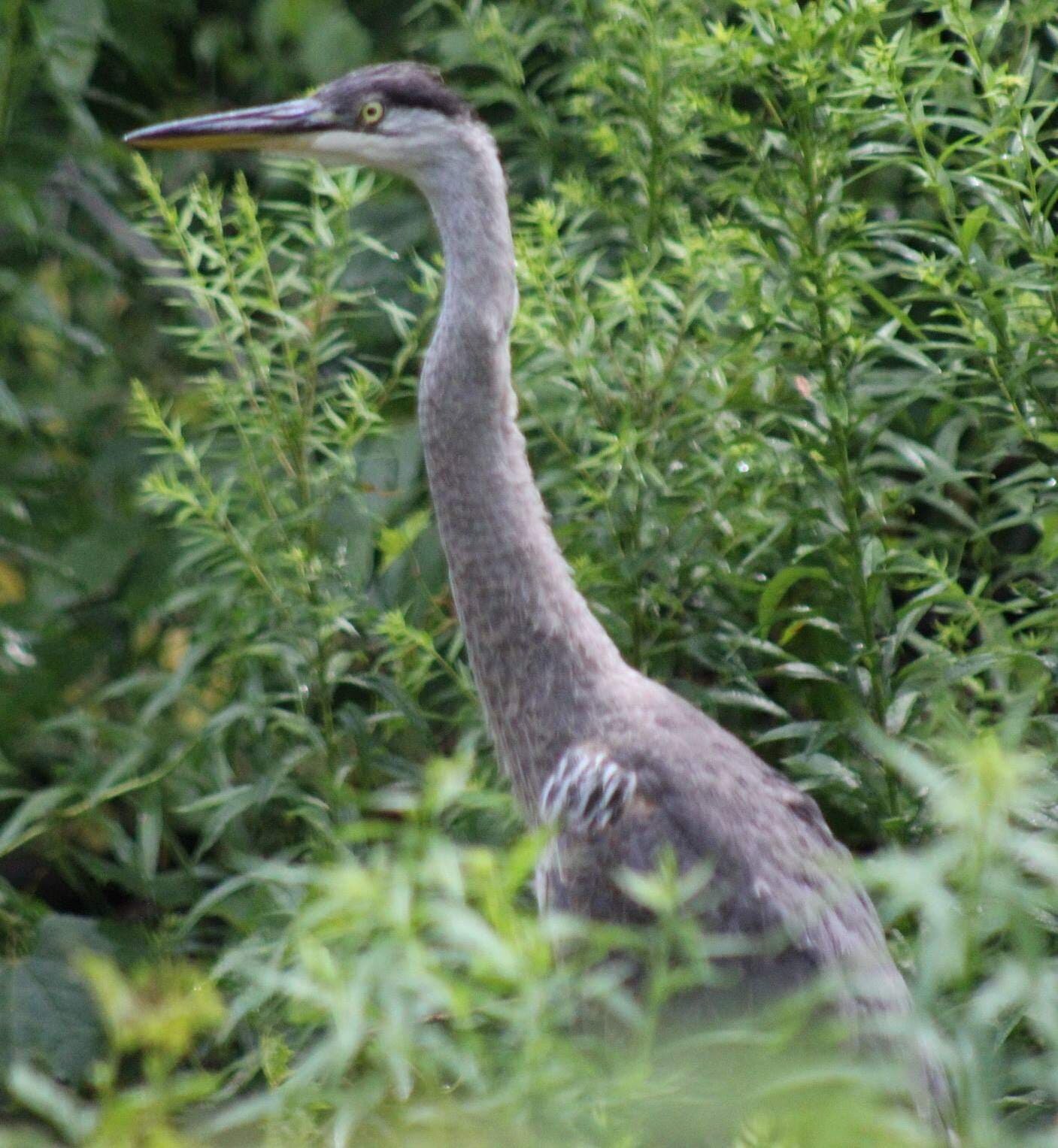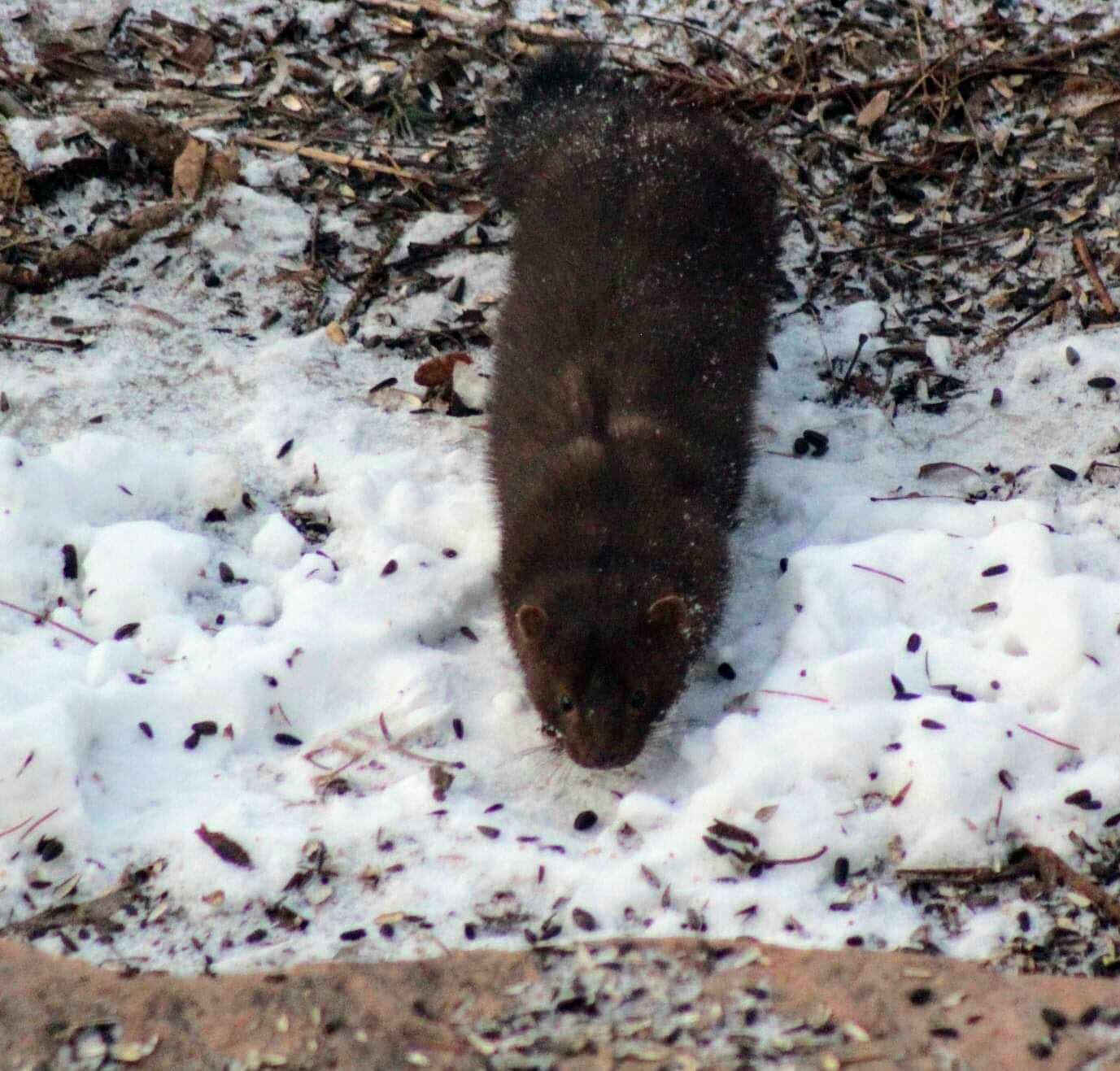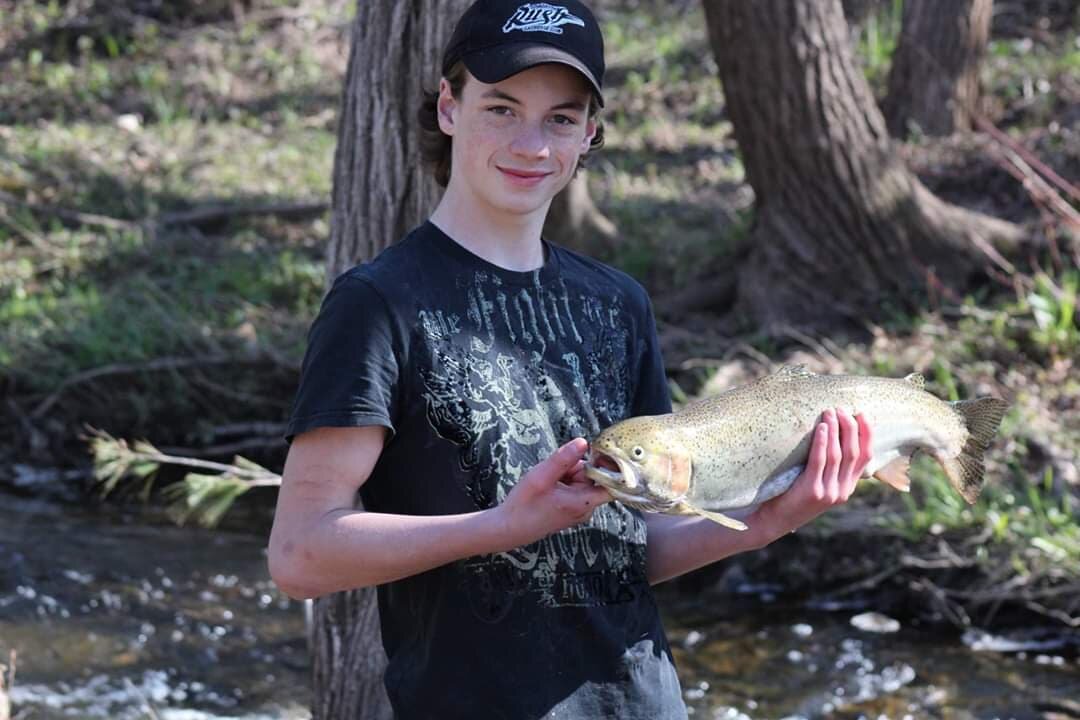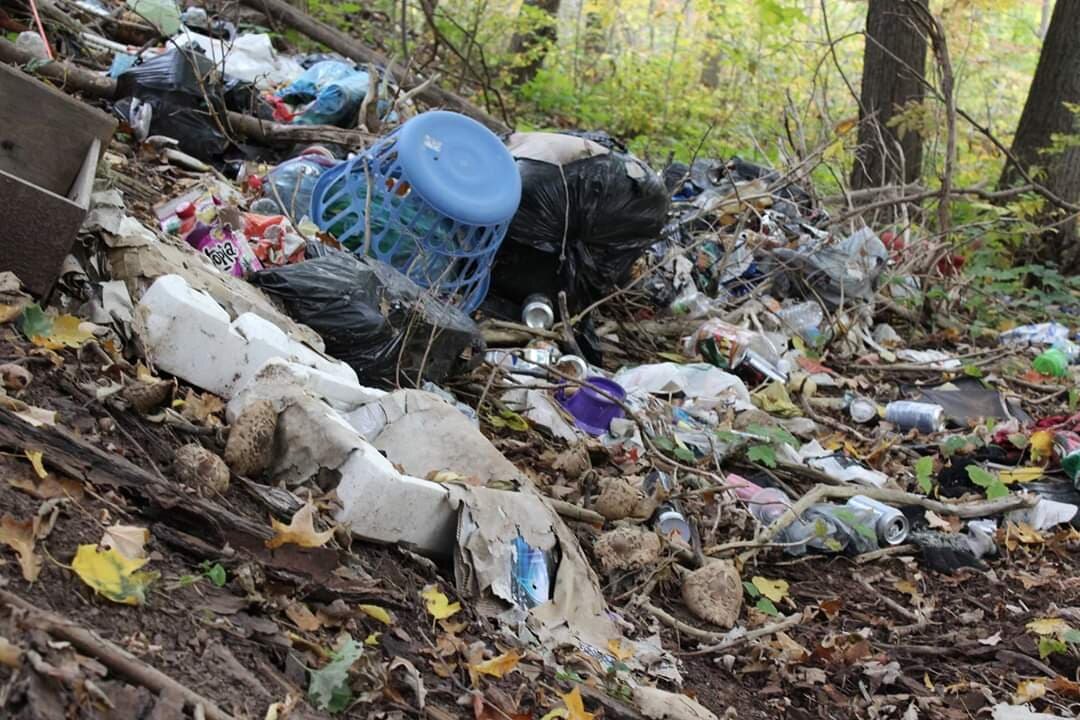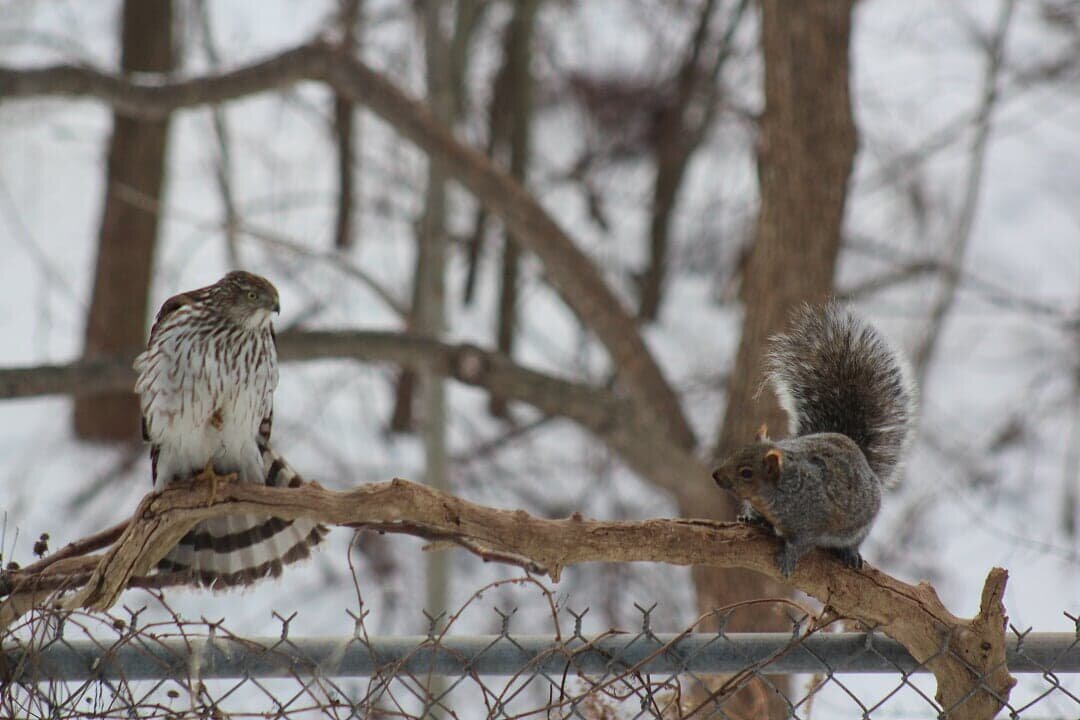Native plants help rewild his woodland garden ark
The coyote making itself at home on his back deck on his facebook page caught my eye, but the fact that Vince Fiorito brought in 50 tons of boulders and rocks into his backyard caught my attention. This guy is serious about rewilding his backyard.
Boulders build foundation for woodland garden
I thought the coyote making itself at home on Vince Fiorito’s back deck was a sign of his commitment to rewilding his backyard, but when he told me about the 40 tons of granite boulders and rocks that he squeezed into his backyard in Burlington Ont., I knew this guy was serious.
Not only is he rewilding the typical suburban-sized backyard, he is extending his efforts into the ravine behind his home and transforming it from a garbage-dumping area that is infested with invasive, non-native vegetation, into an impressive woodland ark filled with native plants and shrubs that are encouraging more fauna to set up homes in and around the area.
(Here is a link to my article on the importance of using native plants in the garden.
Maybe that explains the coyote that couldn’t help checking out his backyard and wandered up on his back deck, or the minks that came hunting squirrels in his yard this winter. Maybe it helps to explain the many small DeKay Brown snakes that call his backyard home. (See a Youtube video of his yard here.)
All you have to do is talk to Vince for a few minutes to realize this guy is serious about rewilding his yard, the ravine behind it, and the entire City of Burlington if given the chance.
Vince has even been recognized by the Hamilton/Halton Conservation Authority for his work on the Sheldon Creek watershed.
Vince Fiorito’s property backs on to a wooded area that he has worked to not only clean up, but transform with native plants into a naturalized woodland where coyotes, mink and a host of reptiles and birds call home.
It’s not the first time he has taken on the challenge. Before moving to Burlington, Vince transformed a former property in much the same way he has at his Burlington home.
More than 20 years ago in Cornwall Ont. Vince decided he could no longer live with the “McHappy” gardens that overwhelmed subdivisions all over his small town, let alone most of North America. It was then, after helping out with a school field trip to rescue trilliums and other spring ephemerals from a future gravel pit to a school yard natural habitat restoration project, that he decided it was time to take action and start cultivating native plants, with a focus on rare local species that were quickly disappearing.
“That is when I became convinced that the lawn and garden industry had created perceptions of problems where none existed (dandelions) so they could sell us solutions which are really problems,” he added.
Twenty steps to rewild your backyard
Remove all or as much grass as possible.
Stop using chemicals on your property to kill flora and fauna. Try instead to deal with problems naturally.
Replace non-native plants and trees with natives whenever and wherever possible.
Create safe habitat for animals, insects and reptiles of all kinds. This can include natural habitat from leaving snags (dead trees) to planting cedars and other evergreens that provide year-round protection. Supplement natural habitats with commercial or man-made structures such as bird houses and roosting boxes.
Consider providing natural nesting habitat for our native solitary bees as well as high-quality homes that allow for easy cleaning and removal of larvae. See my earlier article on the WeeBeeHouse.
Stop picking up leaves in the fall. Countless insects, reptiles and small mammals depend on leaf litter for winter survival. If you must, pile them into a corner or corners of your yard and let nature take care of them naturally.
Provide natural, native food sources for animals and birds from berries and nuts to flower seeds.
Ensure a safe and regular nectar supply in the yard for hummingbirds, pollinators, butterflies and bees.
Provide several sources of water in the garden, from small ponds, to on-ground bird baths that could include some form of moving water from a small solar fountain.
Consider the value of going vertical with more flowering and fruiting vines. These can also provide nesting areas for birds.
Forget a tidy garden. Nature isn’t tidy. Those spent flower stalks you are cutting down and sending to the curb, are home to insect larvae. Leave them be until late spring or early summer when the insects have had time to re-emerge.
Refrain from using gas-powered blowers on your property when a simple light raking will get the job done.
Build brush piles on your property. Even a small brush pile of sticks can be surprisingly productive. If you are having trees trimmed, ask the tree service to leave the cut branches in a pile in a corner of your property. You will save money and create invaluable habitat and hunting ground for birds and other backyard visitors.
Consider creating a hibernaculum as an overwintering area for snakes, insects, small mammals and other reptiles.
Create an open compost pile which will not only provide you with black gold, but will encourage insects and other fauna to use it as food and habitat.
Consider taking the necessary steps to become a certified backyard habitat to inspire neighbours to take action in their own yards.
Join your local garden and native plants organizations and spread the word about the value of rewilding their yards and neighbourhoods.
Always be on the watch for injured or sick animals and take the time to learn who to contact and what to do if you notice an injured animal on the property.
Put up decals, streamers or some other deterrent to keep birds from striking your windows.
Do no harm. It goes without saying that as gardeners we have a responsibility to do no harm to the fauna that share our backyards. Before taking any action in the yard, consider that possible harm that could result. The next time you are severely pruning a shrub or tree, for example, be sure to first check to ensure a family of birds are not depending on that shrub to hide and protect their nestlings. If so, put the pruning off until fall.
Vince’s outstanding photograph of the standoff between the hawk and a grey squirrel at the border of his garden and the ravine is the perfect illustration of wild nature and our suburban wildlife.
Vince’s journey to rewilding success
Vince explains how he originally became interested in the natural world.
“The biodiversity crisis set me on this path. I grew up hearing stories about the passenger pigeon and other species extinctions during my childhood,” he says adding that he also grew up watching the Nature of Things every week since even before Dr. Suzuki hosted the show.
More recently, he joined the Canadian Wildflower Society (the precursor to the North American Native Plants Society) and went to work teaching himself everything he could about native wildflowers. He soon discovered the informative and expert writings of native plant guru and author extraordinaire Lorraine Johnson.
It all added up to an acquired knowledge that he continues to search for and is quick to recommend the expertise of groups like the Ontario Invasive Plant Council and its program Grow Me Instead guide that is currently in its 3rd Edition. and available online. (This release marks the most extensive update of the guide, first released in 2010. The newest update includes nearly 40 new “invasives” and “alternatives.” In addition to the guides, Grow Me Instead also offers seed packets and other resources for Ontario gardeners interested in pursuing native plant gardens.)
Similar groups are available throughout North America. Gardeners are encouraged to look up their local native wildflower associations for specific information on their regions.)
In an article Vince wrote for the North American Native Plant Society newsletter, he describes some of the work he embarked on at his Cornwall property, which he describes as a typical ‘90s subdivision lot.
“I purchased plants and ordered prairie seed mixes from reputable local nurseries that specialized in native plants. I rototilled most of my lawn and smothered the remnants with newsprint and leaf litter. Then I added two tandem truckloads of furniture-size granite rocks and another 7.6 cubic metres (10 cubic yards) of black earth. I rescued deciduous forest floor plants from a nearby quarry site.”
And the conversion had begun.
Several years later, the turfgrass and non-native volunteers were eliminated and his front yard had become a cornucopia of native plants growing between granite boulders. Black-eyed Susans brightened the late summer months with their sunny dispositions, while asters, goldenrods, prairie grasses such a Little bluestem filled out the curb appeal in the front yard.
In the back, Vince planted taller native grasses including switch grass, bottlebrush grass and big bluestem. trilliums, foamflower, blue cohosh and Jack-in-the-pulpits and bloodroot made up just a few of the more than 100 native plant species – including some endangered species such as goldenseal (Hydrastis canadensis) spread throughout the garden.
“To save threatened species from extinction, we must deliberately create habitats for them in urban areas around our homes and businesses. We need to know about local species at risk, the conditions they need to thrive and deliberately recreate these conditions they need to thrive and deliberately recreate these conditions wherever we influence the landscape.”
The price of being ahead of his time
One big problem. Vince was well ahead of his time and at least one neighbour didn’t agree with his non-traditional landscaping style and complained endlessly to anyone who would listen.
It turns out this neighbour wasn’t the only “McHappy” homeowner who thought a chemical-filled lawn and a couple foundation plantings was the way create a beautiful, healthy neighbourhood.
A job offer in Mississauga was too much for Vince to turn down, and so, the home and garden he had worked so hard to transform had to be put up for sale.
And that’s where it sat for months.
Cornwall home buyers were just not ready to take on what they saw as a high-maintenance, non-traditional garden. Eventually, Vince and his family were forced to take a serious cut in the home’s value to help pay for the new owners to bring in bulldozers to remove all the low-maintenance native plantings and boulders, only to replace it with with high-maintenance, non-native turf and a couple of foundation plantings that could, if they played their cards right, eventually grow too large and cover the view out their front windows. (sarcasm intended)
Many of the native plants went to the school where Vince was first inspired on his journey to rewild his Cornwall home.
The family moved to Mississauga for a short time before settling in Burlington, close to the Oakville border and purchased a home that Vince knew would be home to his next backyard rescue. Only this time, his small GTA-sized backyard stretched out as far as he could see and beyond. His backyard might have been small, but it backed on to Sheldon Creek, a stream that emptied into Lake Ontario a few kilometres downstream. A chain link fence was all that separated his property from the surrounding forest and natural area that was just crying out for Vince’s acquired expertise in restoring nature with love and care and, of course, wheelbarrows of native plants.
“Who needs to drive up North. I have Muskoka right in my own backyard.”
A new city a new challenge
And so, in 2013 Vince accepted the challenge of a lifetime to rewild not only his new backyard but to restore what was once a beautiful, natural ravine back to its former glory.
There was one ultimatum he couldn’t ignore, however. It came from his wife, and there was no arguing about it. The front of the home – the curb appeal part – would remain more or less traditional. The trade off seemed a good one and Vince got busy. Very busy.
“Who needs to drive up North,” Vince says describing Ontario’s rugged northern cottage country. “I have Muskoka right in my own backyard,” he adds proudly.
It wasn’t always that way. When Vince moved into his current home the awkward, 75-foot by a mere 30-foot backyard sloped steeply down toward the ravine, and didn’t have a lot going for it accept plenty of non-native plants including an abundance of Burning Bush.
He installed a large cedar deck to flatten out the slope right next to the house and give him the perfect view of his garden, the ravine the birds and the wildlife passing through the ravine.
Then Vince called in reinforcements in the form of 40 tons of rock and stone, and two guys – one wielding a forklift and the other, a small backhoe.
“People joke that I have Stonehenge in my backyard,” he explains.
That’s a lot of stone for such a small yard but there was rhyme and reason for his madness. After pricing out limestone boulders for his yard, he realized that if he went to the source of the rock (a large quarry) he could get a lot better price. One problem however, he had to fill the flatbed truck with rock to get the deal. “That was about four times more rock than I needed,” he explains.
So he filled the truck, hired some manpower and machinery and the rest is history.
Today, native Redbud trees light up the yard in early spring and native plants from milkweed to black-eyed Susans fill in around the rocks, flagstone and boulders.
In the newsletter article for the North American Native Plant Society, he notes: Since moving to Burlington, I have recreated my ark garden concept. I use rocks and organic material to create overwintering habitat for reptiles and many other creatures. I grow endangered hoptrees, (the host plant for the giant swallowtail), which has appeared in my garden for the past three years. I have planted milkweeds, host plants for monarch butterflies larvae, which I saw for the first time last summer, and New Jersey tea (Ceanothus americanus) host plant for the mottled duskywing butterfly.”
Vince is particularly proud of the giant hibernaculum he created in his backyard just with with the introduction of the massive boulders and stone that now make up the foundation of his backyard.
The small DeKay snakes that call his yard home are just an example of the success he has had in attracting and providing safe areas in his garden for surrounding wildlife. These small snakes, which are capable of putting on quite a show when they are scared, live off of insects and slugs and are, therefore, highly prized by knowing gardeners. (A hibernaculum is a location where creatures can seek refuge during winters, often diving beneath the frost zone in a safe, dry environment. They are most often used by snakes, toads, lizards, insects, and rodents.)
But it’s not hard to see Vince’s compassion for the wildlife around his home and throughout the city he now calls home.
Building an “ark” for his forest friends
He refers to his property as an “ark” the same term Mary Reynolds talks about in her book the Garden Awakening. Ms. Reynolds, an acclaimed Irish landscape designer, is calling on gardeners around the world to create “arks” in their yards in the hope that these “arks” can eventually be joined to create wild corridors for native fauna and flora to once again flourish across the urban areas.
In his newsletter article, Vince points out that scientists have concluded that the earth is in the middle of its sixth great mass extinction.
“Species may be going extinct 1,000 times faster than historical background rates and accelerating,” he writes. “Most species are in decline, degrading the biosphpere’s ability to provide the environmental services that clean the air, purify water and rejuvenate soil. If current trends continue, flora and fauna homogenization, invasive organisms, novel pathogens, overexploitation, habitat loss, pollution/toxification and climate disruption may become so severe that within half a century nature may require three to five million years to recover lost biodiversity and ecosystem functionality.”
the statement could not be more clear as we try to recover from a pandemic gripping the world, killing hundreds of thousands of people and forcing the remainder to seek refuge in their homes far from the ravages of the dreaded Covid-19 virus.
“We must seek coexistence with other species on land directly influenced by human activity,” he writes. “To save threatened species from extinction, we must deliberately create habitats for them in urban areas around our homes and businesses. We need to know about local species at risk, the conditions they need to thrive and deliberately recreate these conditions they need to thrive and deliberately recreate these conditions wherever we influence the landscape. To change common perceptions, we must communicate complex stewardship concepts with easily understood words and imagery.
“We need to build ark gardens.”
All true. And, I will add that the world needs more committed naturalists and gardeners like Vince Fiorito.
More links to my articles on native plants
Serviceberry the perfect native tree for the garden
The Mayapple: Native plant worth exploring
Three spring native wildflowers for the garden
A western source for native plants
Native plants source in Ontario
The Eastern columbine native plant for spring
Three native understory trees for Carolinian zone gardeners
Ecological gardening and native plants
Eastern White Pine is for the birds
Native viburnums are ideal to attract birds
The Carolinian Zone in Canada and the United States
Dogwoods for the woodland wildlife garden
Bringing Nature Home by Douglas Tellamy
A little Love for the Black-Eyed Susan
This page contains affiliate links. If you purchase a product through one of them, I will receive a commission (at no additional cost to you) I try to only endorse products I have either used, have complete confidence in, or have experience with the manufacturer. Thank you for your support.


